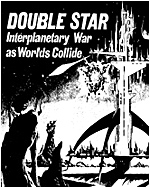 Interplanetary War as Worlds Collide
Interplanetary War as Worlds Collide
GDW (1979, $9.98)
Designer: Marc W. Miller
Players: 2
Playing Time: 2-10 hours
Period: Science Fiction
Scale:
- Turn: two weeks
Map: each hex is an unspecified area of space large enough to hold an inhabited planet
Unit: a single installation, space ship or celestial body
Components:
22”x28” unmounted map sheet; 8 page rulebook; 480 die-cut counters; 2 identical game charts; six- sided die. (My charts have “Double Star, Revised Chart” printed at the bottom.)
Counter Manifest:
60 white counters;
210 Chinese counters -- 191black on green, 5 white on green, 6 green on black, and 8 white on black;
210 Islamic counters -- 191 black on yellow, 5 white on yellow, 6 yellow on black, and 8 white on black.
(Note: The forces in the Chinese and Islamic counter mixes are identical.)
GDW says
“The Epsilon Cetus system, containing an M8 red dwarf and a G0 yellow star, was originally colonized by two independent relocations missions ... the first to arrive, and thus to claim the better G0 system, were those of Islamic origin ... The second mission, of Chinese origin, arrived some 50 years later, in a crippled colony ship . . . they found [the G0 system] jealously guarded by a handful of Islamic ships, and had to crash-land instead in the far poorer quality red dwarf system. This early incident left a lasting animosity between the two cultures ... Over two centuries, the Islamic culture established itself in its system, exploiting its mineral and ecological wealth to the fullest, and developing a thriving interplanetary society. The Chinese colony, on the other hand, was forced to spend the past 150 years in a spartan struggle for survival against marginal environments and the unpredictable flares of [the red dwarf] ... Now, however, the pressure of population on the Chinese and the pressure for additional resource supplies on the Islamic has brought these two cultures into direct conflict.”
The reviewers say:
"Players get pre-game production points ... with which to select from a variety of fighting ships and transports, as well as power plants for the esoteric purpose of separating planetoids from their orbits and hurtling them Kamikaze-style at the enemy planets. Since everything is orbiting steadily, such maneuvers require careful calculation if the player is to avoid sailing by the enemy with his power plants expended and no way of altering course.” Nicholas Palmer in The Best of Board Wargaming (Hippocrene Books, 1980.)
“The strategic planning aspect of Double Star is the heart of the game ... in most scenarios your original purchases will constitute a large part of what you will have to play with ... Even the fastest ships are unable to cross between star systems in one turn, so offensives must be planned in advance and carefully supported and coordinated ... [O]ne of the most solid science fiction games this reviewer has played.” William Fawcett in The Dragon 35.
“The premise of the game is socio-logically absurd. The science is almost equally ludicrous (the planets of this system are not inhabitable as described), but the game is so much fun that lapses in logic are soon forgotten. What powers the game is the insertion of minor touches of detail at the right places, creating a patina of verisimilitude throughout.” David Ritchie in Ares 1.
Comments:
Realistic or not, there’s no denying that Double Star offers a good deal of variety within the bounds of the conflict it depicts. First, the game presents three different scenarios -- a 48 turn scenario depicting a sneak attack by the Chinese, a 36 turn scenario in which each side is conducting a raid on the other, and an all-out Armageddon scenario.
As the scenarios do not involve set forces, each playing offers the chance to experiment with different strategies and match-ups. The players have quite a variety of forces at their disposal. Space-ship types include transports, fighting transports, destroyers, cruisers, battle cruisers, battleships, fighters, and command ships. Terrestrial units include population, industry, power plants, planetary defense weapons, and space-ship bases.
The opposing fleets can also have different capabilities from game to game. Ships grouped into a Task Force gain combat advantages by using one of four formations. However, a Task Force must be trained to use a particular formation, and the ability to use a formation may be lost without continued training (reflecting a degradation of skills.)
Nor is this just another game of spaceships slugging it out. The game lives up to its interplanetary war billing with combat rules covering planetary defense fire and surface strikes against population or installations. Although Double Star shares superficial similarities with other sci-fi games, its unique background makes it truly one of a kind.
Collector’s Notes:
Many of GDW’s sci-fi boardgames from the late seventies and early eighties are highly sought after by collectors. This seems especially true for games growing out of the Traveller RPG universe. As Double Star is not one of the Traveller games, you should still be able to find copies at a decent price. Boone lists low/high/average prices of 4/ 18/8.86 at auction and low/high/average prices of 4/75/20.22 for sale.
GDW’s other flat-box sci-fi titles:
Azhanti High Lightning, Bloodtree Rebellion, Imperium, Triplanetary and Belter.
Back to Simulacrum Vol. 2 No. 3 Table of Contents
Back to Simulacrum List of Issues
Back to MagWeb Master Magazine List
© Copyright 2000 by Steambubble Graphics
This article appears in MagWeb (Magazine Web) on the Internet World Wide Web. Other military history articles and gaming articles are available at http://www.magweb.com